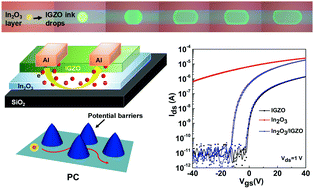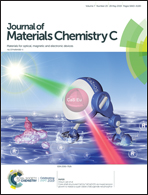High-performance metal-oxide thin-film transistors based on inkjet-printed self-confined bilayer heterojunction channels†
Abstract
The use of a semiconductor heterojunction channel layer has been explored as a method of improving the performance of metal-oxide thin-film transistors (TFTs). Construction of such a heterojunction bilayer is easy using a vacuum sputtering deposition process but difficult using inkjet printing deposition. Some attempts in this direction have not shown significant improvement compared to single channel layer TFTs, and the present work systematically studied inkjet printing of In2O3/IGZO heterojunction channel TFTs. It was found that the bilayer alignment is the most critical factor for obtaining high-performance TFTs. A simple UV/ozone treatment on an inkjet-printed In2O3 layer can be effective in achieving perfect alignment for IGZO printed on the In2O3 pattern area. The mechanism of alignment is not due to the difference in surface energy between the In2O3 layer and SiO2 dielectric layer, but due to the topography of the In2O3 layer sidewall. With well-aligned heterojunction channels, the embedded In2O3 front channel layers transform the carrier transport from the main trap-limited charge (TLC) transport process to the PC-dominated process. Therefore, the maximum mobility of 14.5 cm2 V−1 s−1 was achieved for inkjet-printed In2O3/IGZO TFTs, which is an unattainable result that only increases the proportion of In atoms in IGZO. The average mobility of the In2O3/IGZO TFTs is twice that of single-layer In2O3 TFTs or IGZO TFTs. Furthermore, the In2O3/IGZO TFTs show superior bias stress stability.



 Please wait while we load your content...
Please wait while we load your content...